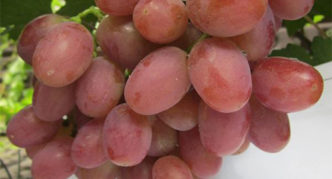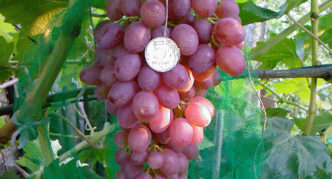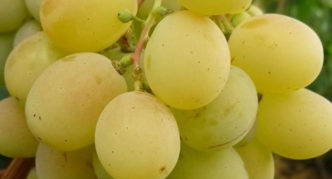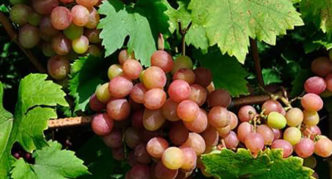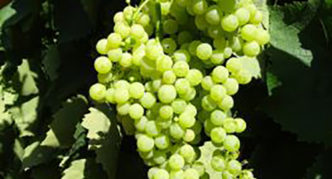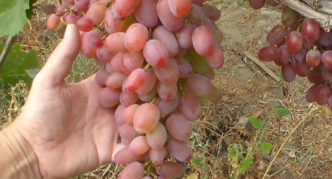In recent years, amateur breeders have often delighted winegrowers with new forms of vines that have excellent characteristics. Both experienced and novice gardeners are invariably interested in novelties, and new varieties of sun berries are rapidly spreading. One of these grapes - the early gourmet and will be discussed. Its taste will be highly appreciated even by gourmets - sophisticated connoisseurs of the taste of food and drinks.
Content
From the history of the Gourmet
By crossing the well-known and beloved grapes Talisman, which has white berries, with rose-berry radiant Kishmish, the famous Novocherkassk amateur breeder Viktor Nikolaevich Krainov received several new hybrid forms of grapes, later called Gourmets.
Now they are known to winegrowers as Gourmets: early, gourmet, flashlight, iridescent, graceful. All of them are distinguished by a peculiar taste with a touch of nutmeg, the richness of the color of pink berries, and the ripening of grapes.
The first hybrid form of early ripening grapes that appeared was originally named Novocherkassk red. Later it was called Gourmet 1–12, Early Gourmet. In 2016, this grape was registered in the state register of the Federal State Budgetary Institution "State Sort Commission" under the name Gurman Krainova and is recommended for growing in a covering form throughout the country.
The early gourmet and his parental forms in the photo
- Early Gourmet Grape
- Radiant Kishmish grape
- Grape Talisman
Early Gourmet portrait
At the beginning of the description of the Early Gourmet, of course, it should be noted that these table grapes ripen very early on, as indicated in the State Register. On the sites of winegrowers the figures are 110-115 days, in other sources - 125-130 days.
Own-rooted seedlings have an average vigor. To feed them, it is recommended to take from 4 to 6 m2 area, that is, plant bushes with a step of 3 meters. The shoots of the current year ripen two thirds of their length. The originator of the variety advises leaving 22-24 shoots on the bush, and pruning for 6-8 buds.
Flowers for all Gourmets are only female, that is, to fertilize the ovary, other grape varieties are needed, blooming at the same time.
On average, the early Gourmet bunches weigh about half a kilogram, but the largest on adult bushes can reach 1.34 kg. They consist of large, egg-shaped grapes with dense skin, weighing an average of about 9 grams. The extraordinary taste of their fleshy pulp with a bright aroma of nutmeg was rated by tasters at 9.1 points. Inside the berries there are 2-3 pieces of medium-sized seeds. The juice is colorless.
When the Gourmet is ripe early enough to be cut, the grapes contain 15.6 sugars and 4.9 grams of titratable acids per liter of juice.
During variety trials, the variety showed an average yield of 20 tons per hectare. Winegrowers note that 6-8 kilograms of berries can be harvested from an adult bush, subject to agricultural practices, and they do not crack even with very heavy precipitation and are not damaged by wasps.
In the practice of growing Gourmet early, wine-growing enthusiasts note a fairly frequent disease of this grape with false and true powdery mildew. Professionals of the "State Sort Commission" assessed the resistance to these diseases at the level of 3.5 points. To protect the variety from diseases, the distributors of planting material recommend two treatments:
- apply Ridomil Gold before flowering;
- use Cabriotope after flowering.
In both cases, using the drugs, you must strictly follow the instructions for use given to them.
The grapes are unstable to grape phylloxera, therefore, in areas infected with this pest, Gourmet is propagated by early vaccinations. The affinity of the variety (compatibility with rootstocks) is under study.
The cultivation of this grape variety is recommended in a covering form, since it has a very low frost resistance at the level of -23–26 ºС.
The early Gourmet harvest must be rationed, otherwise the berries will be small and lose their taste, and the ripening period will be delayed. After flowering and the formation of ovaries, about a third of them are removed.
In a thoroughly disinfected cool (from zero to -1 ºС) storage facility, you can enjoy the harvest until the spring of next year.
Early Gourmet grapes (video)
Growing a Gourmet
Cuttings and self-rooted seedlings of the Early Gourmet variety root well, so there are no peculiarities of their planting.
The features of early Gourmet care, somewhat different from operations with other grape varieties, include:
- Spring feeding with mineral fertilizers:
- before flowering, preparations containing potassium and phosphorus (potassium monophosphate, nitrophoska and others) are introduced in accordance with the instructions for them, fertilizers containing a large amount of nitrogen, as recommended for low-growing grapes, are not applied in order not to stimulate the development of infertile shoots;
- after flowering, foliar feeding is carried out on cloudy days at a temperature of 18-22 ºС with preparations containing zinc, iron, manganese (the most effective is the use of chelates that are well absorbed by plant leaves: iron chelate, manganese chelate and others).
- Disease prevention.
To prevent fungal diseases of the Gourmet early before and after flowering, it is treated with fungicides (systemic, such as Topaz or Quadris, contact Omal, Rovrayt or the like, combined - Ridomil Gold, Cabrio Top, Shavit).
Winegrowers who grow organic products use the biological products Trichoderma, Fitosporin and others for the same purposes. Some of them are able to suppress up to sixty types of pathogens of grapes and other plants. Each drug has detailed instructions for preparing the working solution and the frequency of necessary treatments. The only significant disadvantage of biological products is the need to re-treat plants after heavy rains.
- Early gourmet can be damaged by grape or spider mites. When these pests are detected, the vines are treated with insecticides - drugs that affect all insect pests, or acaricides - special chemicals that affect ticks. As an example of a modern means of simultaneously combating fungal diseases and pests of grapes, one can call the Grape Rescuer drug. In parallel, it is an ecological plant growth stimulant. For treatment, three ampoules of the Rescuer are dissolved in ten liters of water. The effectiveness of the drug, depending on the weather, lasts 3-4 weeks.
- The low resistance of the early Gourmet to the winter cold makes it necessary to grow it only using a shelter for the winter. To do this, the vines are removed from the supports, bent to the ground, covered with straw, hay, and on top with dense agrofibre, which is attached to the ground or arched supports over the grapes.
Is Gourmet Better Than Other Varieties
Without their own practical experience, you can evaluate how good a particular grape is by comparing it with similar varieties according to descriptions in official sources. Even on the forums of winegrowers on the network, the information is not always objective, it is very dependent not only on the region, but also on the area where the grapes grow, and even the experience of the winegrower himself.
In the state register, you can choose several varieties in which the ripening period is very early, like the Gourmet. In this case, we will choose those that are recommended for cultivation throughout the country. Such initial characteristics have, for example, the varieties Cocktail and Helios. Let's compare the rest of their characteristics according to the data that are given in the state register.
| Early gourmet | Cocktail (raisins) | Helios | |
| Bush size | medium-sized | vigorous | medium-sized |
| Color functionality | female | bisexual | bisexual |
| Average bunch weight (grams) | 524 | 353 | 525 |
| Sugar at ripeness (%) | 15,6 | 16,2 | 15,1 |
| Titratable acids (g / dm3) | 4,9 | 7,0 | 5,6 |
| Assessment by tasters (point) | 9,1 | 8,3 | 9,0 |
| The presence of seeds in berries | 2-3 medium | 1-2 rudimentary | 1–2 |
| Productivity (average t / ha) | 20,1 | 32,2 | 12,3 |
| Powdery mildew resistance (score) | 3,5 | 2–2,5 | average |
| Culture | covering | not indicated | covering |
According to the data presented, it is impossible to unambiguously single out one of these varieties as clearly superior to others in all parameters. Often, beginner growers prefer raisins such as Cocktail. Moreover, its yield is much higher. However, Gourmet and Helios taste better, and the bunches are larger, and the disease resistance is higher. There is only one conclusion - the decision to prefer this or that grape variety is taken by the grower, in accordance with his requirements and tastes.
Early gourmet and grape varieties compared to him in the photo
- Early Gourmet variety
- Variety Cocktail
- Helios variety
Winegrowers' reviews about the early Gourmet variety
The early gourmet cannot take root in my area. For some reason he has no luck. At first I was vaccinated for 2 years and bore fruit a little. Then, for some reason, it began to disappear. I planted my own rooted. Last year, in the third year, it gave several clusters, but it was with peas. This year in April it is very cold, and there is only one small bunch hanging. If not for his excellent taste, I would have said goodbye to him long ago.
My early Gourmet ripens more often in early September. Bunches from 500 to 1000 grams, but there are individual up to 1200-1300 grams. During flowering, we do not have a strong heat and the grapes are better pollinated, maybe that's why the clusters are larger and the harvest from a bush is 8 kg or more, which is not bad for us Siberians. Our summer is short and in order for the vines and berries to ripen, we have to ration the grapes with shoots, and inflorescences, and bunches, depending on the weather, and if not rationed, then the taste will not be up to par. We are trying to store grapes of those varieties that are stored until the New Year and beyond. It's nice to eat your grapes in winter, and it's better for health.
GR 4 bushes: 1 in the greenhouse, 3 in the exhaust gas. In the greenhouse, a normal harvest, on the street this year it is not clear: it set well, and then a lot of ovaries crumbled, but then, I saw this in the first, strong growth of stepsons went, pinched over the 2nd leaf, after a while from the bosom 2- the inflorescence went on the first leaf, and then the growth of the shoot. And so on every 2 stepson, I left it, I'll see what happens. Who had this?
But I don’t share the general enthusiasm for the Gourmet, delicious of course, but to the point, all the same sprinkles all over, and ran with puffs, and processed gelatinous boron, nothing helps, like last year. Or is it just me? In my opinion, he has a common sore with the Monarch, and why he is so tasty to me, they also named it a variety. And most importantly, I replaced them with 2 bushes that were not previously satisfied, in general, I changed the awl for soap. At first it seemed that it was perfectly pollinated, but for two days and only sticks will hang.
From all the information given, the conclusion suggests itself that an early Gourmet, of course, is a promising grape variety, but its only absolutely indisputable advantage is its unsurpassed original taste. He is also good in appearance. The opinions of practicing winegrowers about the Early Gourmet are very different and sometimes diametrically opposed. To grow it or not is an absolutely individual decision. If you want to have early very tasty grapes, you may have to pay more attention and care to it.

